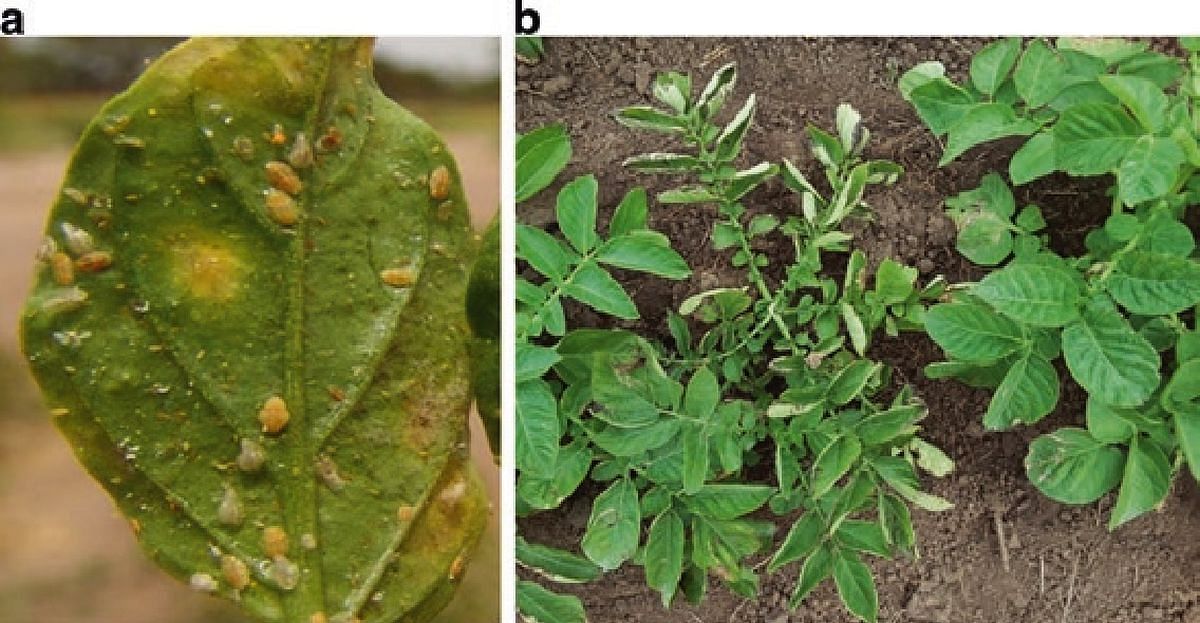Scientific description of the Potato Psyllid (2020)
The authors of this content are Jürgen Kroschel, Norma Mujica, Joshua Okonya, Andrei Alyokhin
Bactericera (ex-Paratrioza) cockerelli (Sulc) (Hemiptera: Triozidae)
Distribution
The potato psyllid Bactericera cockerelli is native to North America and occurs mainly in the Great Plains region of the United States, from Colorado, New Mexico, Arizona, and Nevada, north to Utah. It is also found in Mexico, Guatemala, Honduras, and Nicaragua, and is suspected to be present in other Central American countries, including El Salvador image below).
Following an accidental introduction, B. cockerelli has become widespread in New Zealand (CABI 2016; OIRSA 2016; Rehman et al. 2010).

Nymphs of Bactericera cockerelli infesting potato leaves (a) and potato plant affected with potato purple top (b). (Courtesy: CIP)
B. cockerelli is found primarily on plants of the family Solanaceae.
The psyllid infests and develops on a variety of cultivated and weedy plant species including potato, tomato, pepper, eggplant, and tobacco as well as noncrop species such as black nightshade, groundcherry (Physalis spp.), and matrimony vine (Lycium spp.) (CABI 2016).
Both adults and nymphs feed by sucking the sap of plants. Direct damage is caused by injecting substances that destroy plant cells (toxins). Chlorophyll production is interfered causing leaf yellowing and stuntedness, which together result in a condition known as psyllid yellows.
Indirect damage is related to the transmission by nymphs and adults of the bacterium Candidatus liberibacter solanacearum (psyllaurous) that causes infectious diseases known as permanent tomato (PT), potato purple top (PM), and zebra chip.
Typical symptoms of potato zebra chip include yellowing and curling of foliage, stunted growth, formation of aerial tubers, shortened and thickened internodes, leaf scorching, reduced tuber size and yield, and early plant death.
Belowground, zebra chip is characterized by the presence of collapsed and necrotic stolons, and browning of internal vascular tissues, which, upon frying, exhibits dark brown streaks, hence the term “zebra chip” (Martin 2016; Rehman et al. 2010; Garzón 2002).
Potato zebra chip disease is a serious disorder of potatoes that has resulted in millions of dollars in losses to the potato industry. The characteristic symptom is dark striping in the tuber when fried as French fries or potato chips, rendering the infected potatoes unmarketable.
It has been determined that C. liberibacter is transmitted to potato very rapidly by the potato psyllid, and that a single psyllid per plant can successfully transmit this bacterium to potato in as little as 6 h. This low psyllid density, coupled with a short inoculation access period, represents a substantial challenge for growers in controlling the potato psyllid and preventing zebra chip transmission.
Just a few infective psyllids feeding on potato for a short period could result in substantial spread of the disease within a potato field or region (Garzón 2002; Rehman et al. 2010; Munyaneza et al. 2007, 2009).
- Monitoring pest population.
Early season management of this insect is crucial to minimize damage and psyllid reproduction in the field. Egg and nymphal stages require visual examination of the foliage. Adults can be sampled with yellow traps, which are effective in detecting immigrant populations and must be installed from the beginning of the cropping season.
Low populations before or at the start of tuber formation reduce production significantly, but once the tubers are formed plants tolerate direct damage (Henne et al. 2010; Butler and Trumble 2012; Workneh et al. 2012). - Plant resistance.
The most valuable and effective strategies to manage zebra chip would likely be those that discourage vector feeding, such as use of plants that are resistant to psyllid feeding or less preferred by the psyllid. Unfortunately, no potato variety has so far been shown to exhibit sufficient resistance or tolerance to zebra chip or potato psyllid. - Biological control.
Several predators and parasites of B. cockerelli are known, though there is little documentation of their effectiveness. In New Zealand, fungal isolates of Lecanicillium muscarium (Petch) Zare & W., Isaria fumosorosea (Wize), and commercial formulations of Beauveria bassiana Balsamo-Crivelli (Vuillemin), I. fumosorosea, and Metarhizium anisopliae (Metchnikoff) Sorokin were successfully tested against nymphs of B. cockerelli in laboratory assays and adults and nymphs in greenhouse assays, outperforming a conventional spiromesifen insecticide (Mauchline and Stannard 2013). Commercial formulations of Metarhizium anisopliae (F52®, Novozymes Biologicals) and Isaria fumosorosea (Pfr 97®, Certis USA) significantly reduced plant damage and potato zebra chip symptoms in Weslaco, Texas (Lacey et al. 2011). - Chemical control.
Good insecticide coverage or translaminar activity is important because psyllids are commonly found on the underside of the leaves. Because several generations often overlap, caution should be taken when selecting and applying insecticides targeted against the potato psyllid in relation to which life stages are present in the crop and timing of insecticide applications.
B. cockerelli is often associated with the pathogen Candidatus liberibacter solanacearum and this represents the main challenge in the search for IPM components that can be integrated into the potato crop.
Several management strategies have been proposed such as cultural, biological, and chemical control.
In New Zealand, the proposed IPM strategy includes careful timing of insecticide applications, incorporating alternative chemicals, integrating treatments with vector monitoring or sampling, establishing action thresholds (although this is difficult for vectors), determining the likelihood of infections throughout the year, and combining chemical applications with resistant or tolerant varieties (Vereijssen et al. 2018).
